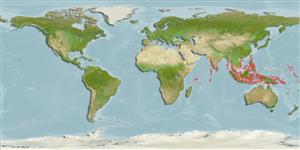>
Ovalentaria/misc (Various families in series Ovalentaria) >
Pomacentridae (Damselfishes) > Pomacentrinae
Etymology: Amphiprion: Greek, amphi = on both sides + Greek, prion, -onos = saw (Ref. 45335).
Eponymy: Albertus Seba (1665–1736) was a very wealthy Dutch apothecary, zoologist and natural history collector, who published a lavish series of illustrations depicting, in part, marine life of the Indo-Pacific. [...] (Ref. 128868), visit book page.
More on author: Bleeker.
Environment: milieu / climate zone / rango de profundidad / distribution range
Ecología
marino asociado a arrecife; no migratorio; rango de profundidad 2 - 25 m (Ref. 7247). Tropical; 24°N - 11°S
Indian Ocean: Arabian Peninsula, India, Sri Lanka, Maldives, Andaman Islands, and Sumatra and Java in Indonesia.
Tamaño / Peso / Age
Madurez: Lm ? range ? - ? cm
Max length : 16.0 cm TL macho / no sexado; (Ref. 9710)
Short description
Claves de identificación | Morfología | Morfometría
Espinas dorsales (total) : 10 - 11; Radios blandos dorsales (total) : 14 - 17; Espinas anales: 2; Radios blandos anales: 13 - 14.
Body shape (shape guide): fusiform / normal; Cross section: compressed.
Found in coastal waters and lagoons. They grow rather large (Ref. 48636). Oviparous, distinct pairing during breeding (Ref. 205). Eggs are demersal and adhere to the substrate (Ref. 205). Males guard and aerate the eggs (Ref. 205). Associated with the anemone Stichodactyla haddoni (Ref. 5911). Diurnal species (Ref. 113699).
Life cycle and mating behavior
Madurez | Reproducción | Puesta | Huevos | Fecundidad | Larva
Oviparous, distinct pairing during breeding (Ref. 205). Eggs are demersal and adhere to the substrate (Ref. 205). Males guard and aerate the eggs (Ref. 205). Also Ref. 7471.
Allen, G.R., 1991. Damselfishes of the world. Mergus Publishers, Melle, Germany. 271 p. (Ref. 7247)
IUCN Red List Status (Ref. 130435: Version 2025-1)
Threat to humans
Harmless
Human uses
Pesquerías: comercial; Acuario: Comercial
Herramientas
Special reports
Download XML
Fuentes de Internet
Estimates based on models
Preferred temperature (Referencia
123201): 27.3 - 29.3, mean 28.8 °C (based on 1767 cells).
Phylogenetic diversity index (Referencia
82804): PD
50 = 0.5000 [Uniqueness, from 0.5 = low to 2.0 = high].
Bayesian length-weight: a=0.01479 (0.00755 - 0.02898), b=3.04 (2.87 - 3.21), in cm total length, based on LWR estimates for this species & (Sub)family-body (Ref.
93245).
Nivel trófico (Referencia
69278): 2.7 ±0.31 se; based on food items.
Resiliencia (Referencia
120179): Alto, población duplicada en un tiempo mínimo inferior a 15 meses (Preliminary K or Fecundity.).
Fishing Vulnerability (Ref.
59153): Low vulnerability (10 of 100).
🛈
